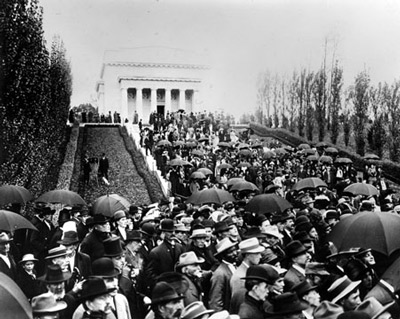The Abraham Lincoln Birthplace National Historic Site contains a nationally significant memorial landscape, honoring the sixteenth president of the United States and representing the Neoclassical style of memorial landscape design.
The "museum will house, as its central object of interest, the weather-worn little log cabin in which Abraham Lincoln was born." The project "will tell the early yeomanry life out of which Lincoln came [and] will be kept a farm..." Richard Lloyd Jones, "The Lincoln Centenary," published in Collier's Weekly (February 15, 1908)

NPS/Abraham Lincoln Birthplace National Historical Park
The location of Lincoln’s birthplace is commemorated by John Russell Pope in a Neoclassical style Memorial Building and associated formal landscape. The Memorial Landscape is not only an extension of Pope’s classical architectural design, but an important example of Lincoln commemoration at the turn of the twentieth century. The temple form, ordered stairway, and symmetrical landscape plantings represent the use of the Neoclassical style to commemorate birthplace of Abraham Lincoln, one of the most significant and honored American presidents.
The site's significance is connected to these commemorative features. The Lincoln tenure is significant (1808 to 1811), although the landscape from that period retains very little integrity. Only the location of the spring and boundary oak remain. The memorial landscape period of significance (1909 to 1935) includes the landscape development by Pope and later improvements by the Federal government.

NPS
The site is part of the original Sinking Spring Farm established in 1808 by Thomas Lincoln, Abraham’s father. The one-room log cabin was built on a knoll adjacent to the spring (for which the 300 acre farm was named). Abraham Lincoln was born on this landscape on February 12, 1809. The property was only owned by the Lincolns until 1811, when a financial disagreement forced the family to move to nearby Knob Creek.

NPS
The farm was subdivided and changed owners several times over the next eighty years. In 1894, Alfred W. Dennett bought the property to preserve the birthplace of Lincoln and reconstructed a log cabin for display. The cabin, which is currently displayed in the Memorial Building, is not conclusively identified as the cabin where Lincoln was born, but it does date to the nineteenth century. The Lincoln Farm Association (LFA) organized to buy the land and permanently preserve the birthplace site by constructing a fitting memorial to Lincoln. A committee led by Thomas Hastings and Charles McKim selected John Russell Pope to design the memorial.
The Memorial Building was constructed of granite and concrete with columns and a parapet on the main elevation and a large interior exhibition space which housed the re-erected log cabin. The controlled approach to the Memorial Building consists of a terraced stairway with four landings and 56 steps, one for each year of Lincoln’s life. Clipped hedges paralleled the stairs and enclosed a rectilinear area of grass. Lombardy poplar plantings (having a columnar effect) provided a visual edge beyond the hedges. The Abraham Lincoln Birthplace Memorial Building and Landscape are significant contributions to Neoclassical architecture, landscape architecture, and the memorialization of Abraham Lincoln.

NPS
The revival of classical architecture coincided with the popular City Beautiful movement and was readily appropriate for the plethora of monuments and memorials built at the time. After his assassination, Abraham Lincoln became an American martyr and by the turn of the century was a momentous figure comparable to the founding fathers. The construction of the Lincoln Birthplace Memorial was the first major memorial dedicated to Lincoln besides a few smaller statues in Washington DC.
The Memorial Landscape retains integrity despite some changes to the original Pope design. The location and association, primary reasons for the memorial to Abraham Lincoln, are unchanged. The commemoration of Abraham Lincoln at his birthplace is a significant contribution by John Russell Pope to the style of memorial architecture in America. The Neoclassical architecture of Pope reflects the national sentiment for Lincoln, while the ordered landscape imposed on the natural topography highlights the stature he reached in American history.
Quick Facts
- Cultural Landscape Type: Designed
- National Register Significance Level: National
- National Register Significance Criteria: A,C
- Periods of Significance: 1808-1811; 1909-1935
Landscape Links
Last updated: January 28, 2023
